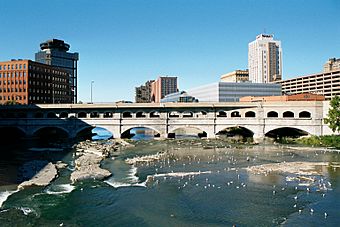Broad Street Bridge (Rochester, New York) facts for kids
Quick facts for kids |
|
|
Erie Canal: Second Genesee Aqueduct
|
|

Broad Street Bridge, 2001
|
|
| Location | Broad St., Rochester, New York |
|---|---|
| Area | less than 1 acre (4,000 m2) |
| Built | 1836 |
| Architect | Roberts, Nathan |
| NRHP reference No. | 76001228 |
| Added to NRHP | September 29, 1976 |
The Erie Canal: Second Genesee Aqueduct, also known as the Broad Street Aqueduct, is a very old stone bridge in Rochester, New York. It was built a long time ago, between 1836 and 1842. This special bridge was designed to carry the famous Erie Canal over the Genesee River.
An aqueduct is like a water bridge. It allows boats and water to travel over a valley or another river. This one is quite large, stretching about 800 feet (240 m) long and 70 feet (21 m) wide. It has strong walls on both sides. The Broad Street Aqueduct was one of four big aqueducts built for the Erie Canal system in the mid-1800s. Later, in 1927, it was changed to carry cars and was named Broad Street. It even carried part of the Rochester Subway for a while!
Contents
What is the Broad Street Aqueduct?
The Broad Street Aqueduct is a historic structure that played a big role in transportation. It's a type of bridge called a aqueduct. This means it was built to carry water, specifically the Erie Canal, across the Genesee River. Imagine boats floating high above another river!
This amazing stone structure is located right in the city of Rochester, New York. It's a great example of engineering from the 1800s.
Building a Water Bridge
Construction of the aqueduct began in 1836 and finished in 1842. It took six years to build this strong stone bridge. The main purpose was to help the Erie Canal continue its journey. The canal was very important for moving goods and people across New York State.
The aqueduct is 800 feet (240 m) long, which is about the length of two and a half football fields. It's also 70 feet (21 m) wide, with thick, strong walls on its sides. These walls helped hold the canal water in place as boats passed over the Genesee River below.
From Canal to Road
For many years, the aqueduct served as a busy part of the Erie Canal. Boats traveled across it, connecting different parts of the state. However, as times changed and cars became more common, the canal's use decreased.
In 1927, the aqueduct got a new job. A roadbed was built on top of it to carry cars. This new road was named Broad Street. This shows how old structures can be reused and adapted for modern needs. The aqueduct even carried a section of the Rochester Subway for some time, making it a truly multi-purpose bridge!
Why is This Aqueduct Important?
The Broad Street Aqueduct is a significant part of history. It reminds us of the importance of the Erie Canal. The canal helped Rochester grow into a major city. It made it easier and cheaper to transport goods.
Because of its historical value, the aqueduct was added to the National Register of Historic Places in 1976. This listing helps protect important places like this one. It ensures they are preserved for future generations to learn from and enjoy.
Gallery
-
Aqueduct view from Rochester Business Institute
-
Broad Street Aqueduct in Rochester, New York









